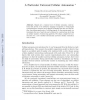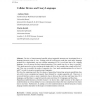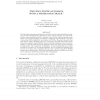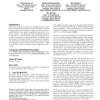13 search results - page 2 / 3 » Real-Time Language Recognition by Alternating Cellular Autom... |
CORR
2008
Springer
13 years 7 months ago
2008
Springer
Abstract. Signals are a classical tool of cellular automata constructions that proved to be useful for language recognition or firing-squad synchronisation. Particles and collision...
FUIN
2007
13 years 5 months ago
2007
Devices of interconnected parallel acting sequential automata are investigated from a language theoretic point of view. Starting with the well-known result that each unary language...
PACT
1999
Springer
13 years 9 months ago
1999
Springer
We introduce a new model for objects which can move around on a cellular grid. The model consists of two phases, the movement phase and the con ict resolution phase. In the movemen...
JALC
2007
13 years 5 months ago
2007
The basic finite automata model has been extended over the years with different acceptance modes (nondeterminism, alternation), new or improved devices (two-way heads, pebbles, ...
AVI
2008
13 years 7 months ago
2008
This paper presents an interactive visualisation system that assists users of semi-automatic speech transcription systems to assess alternative recognition results in real time an...




